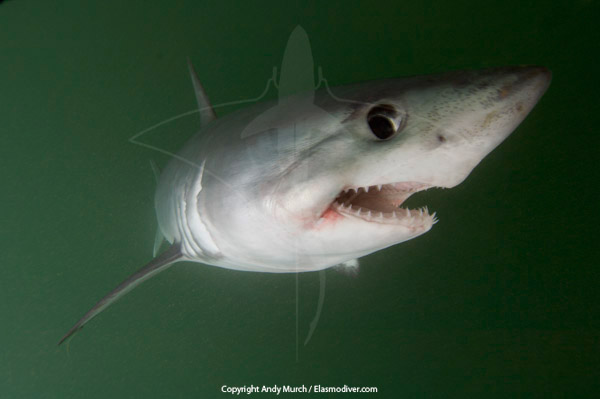2. when i re watched an episode of "the Blue Planet", the seasonal seas episode, i was reintroduced to a shark that i know little about but is very interesting. the Porbeagle Shark, or Salmon Shark, which is a shark in the mackerel family. Here, I'll let you learn for yourself . . .
The porbeagle is a member of the group known as the mackerel sharks--Isuridae or Lamnidae--probably the most notorious of all shark families. There are only three genera, Carcharodon, Lamna, and Isurus, but in these genera can be found three of the most well-known sharks ever to swim the seas: the mako, the great white, and the extinct Megalodon. All these sharks have enough in common to classify them as a single family: they share the same fusiform, tapered shape, and the same pointed snout. They all have laterally flattened caudal keels (although the porbeagle has a secondary caudal keel as well), their tails are almost equally lobed and muscular, and they have an insignificant second dorsal fin. They all swim stiffly, flexing only the tail that is strengthened by the muscular keels, and they are capable of incredible speed. Some say the mackerel sharks are the fastest animals in the sea.
The porbeagle has several common names, including mackerel shark, bonito shark, and salmon shark, derived from its preying upon, rather than its resemblance to, these fishes. The value of Linnean binomial nomenclature is obvious in a situation like this; in one location it's a porbeagle, in another it's a salmon shark, and off the coast of Maine, it's a bluedog. If it's a shark with a conical snout, sharp, narrow teeth, a symmetrical tail, and a double keel at the base of the tail, it's Lamna nasus. That's if it's found in the Atlantic. If it's found in the Pacific, it is Lamna ditropis, the Pacific porbeagle. Ditropis, by the way, means "double keel," and nasus means nose, both of which refer to the salient characteristics of the species. This double keel is unique to the genus Lamna. The upper, wide keel is similar to that of the other mackerel sharks, but the second and smaller keel, located on the lower lobe of the tail fin itself, occurs only in the porbeagles.
There is no problem in differentiating the porbeagle and the great white--the white is usually lighter in color (but not white), while the porbeagle is usually a dark bluish or brownish gray above, fading to white below. It is often makos that are mistaken for porbeagles, but the mako is a more slender fish, and it is a rich blue color above. The porbeagle also has a white patch at the posterior base of the dorsal fin.
The teeth of the mackerel sharks are interesting for reasons other than their use as a genus determinant. Most sharks have teeth that differ in the upper and lower jaws. This differentiation is based on the separate functions that the jaws perform. The lower teeth are often narrower and more pointed, and they are used to pierce and hold the prey, while the broader serrated upper teeth are protruded, and the head is twisted, thus removing a bite of flesh. In other words, the sawlike edges of the upper teeth function as a knife, while the lower teeth serve to hold the prey, much in the manner of a person carving a roast with a knife and fork. (This arrangement presupposes a prey animal too large to be engulfed in one gulp.) In the jaws of the mako and the porbeagle, both the upper and lower teeth are narrow and smooth-edged, which would indicate that both sets are used for grasping and that the prey is swallowed whole. This is borne out by many studies of the stomach contents of mackerel sharks, which show many fish more or less undamaged, except for the stablike puncture wounds made by the teeth. The teeth of the porbeagle are pointed and narrow, and they differ from those of the mako by the presence of small cusps on either side of each tooth.
Porbeagles are pan-oceanic, having been reported in the North Atlantic, the North Sea, off England, Scotland, Iceland, Newfoundland, New England, and from corresponding latitudes in the southern hemisphere. All the porbeagles can be characterized as temperate or even coldwater species. This is one of the reasons that there have been no documented attacks on swimmers; even though the porbeagle is certainly capable, there are just not very many people in the waters where the porbeagle lives.
Given its illustrious relatives, it is no wonder that the porbeagle has been given short shrift. The shark with the funny name has not been incriminated in unprovoked attacks on humane and it does not perform elaborate high jinks when it is hooked. It may appear to be the poor relation of the more flamboyant mackerel sharks, but it is a full member of the family, a swift and capable hunter. The porbeagle is not as deadly as the white or as graceful as the mako, but it is among the fastest swimmers in the sea, and therefore it ranks at the very peak of the food chain. It is the "top predator" in its own territory.
Source: The Book of Sharks by Richard Ellis
thanks for learning with me.
coming soon: The Pursuit: Part Two



No comments:
Post a Comment